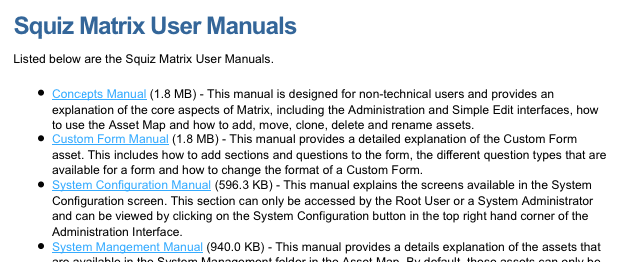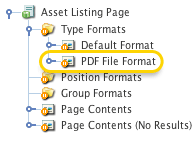Type Formats
Last Updated: 17 Dec 2015

The Default Format Bodycopy
By default when you create an Asset Listing, a Type Formats Folder containing a Default Format Bodycopy is created underneath it, as highlighted in the figure to the right. This is used to define what information to display for each asset in the list.
Bookmarks to the headings on this page:
For example, for the Asset Listing shown in the figure below, a link to the asset along with the size of the file and the information that has been added in the metadata field called description is being shown for each asset in the list. This has been defined in the Default Format Bodycopy.

An example Asset Listing
This Default Format, however, is used for all asset types being displayed in the list. For example, if you have created an Asset Listing page showing all PDF Files and MS Word Documents in a Site, the layout defined in the Default Format Bodycopy will be used for both asset types. You can, however, create a Bodycopy asset for each asset type. For example, you can create a Bodycopy for the PDF Files and a Bodycopy for the MS Word Documents.
The advantages of creating a Type Format Bodycopy for a specific asset type are as follows:
- You can change the layout for each asset type being shown in the list. For example, if the Asset Listing is showing Standard Pages and PDF Files, you can show the Standard Pages in green text and the PDF Files in red text.
- Squiz Matrix can provide you with more specific keyword replacements to use within the Bodycopy. For example, for a PDF File, along with the standard keyword replacements it can also show the keyword replacements File Size and Friendly name for the file. These additional keyword replacements will appear in the select keyword list in the WYSIWYG Editor toolbar.
Creating a Type Format Bodycopy
To create a Type Format Bodycopy, right click on the Asset Listing in the Asset Map and select Display Formats. In the Customised Asset Type Formats section, select the asset type in the New Type Format field and click Commit. A hyperlink to the Bodycopy asset will appear in the Customised Asset Type Formats section, as shown in the figure below.

The Customised Asset Type Formats section

The Type Formats Bodycopy
The Bodycopy will also appear under the Type Formats Folder in the Asset Map, as highlighted in the figure to the right.
Editing a Type Format Bodycopy
To edit a Type Format Bodycopy, right click on the Bodycopy in the Asset Map and select Edit Contents. Click on the ![]() icon – the WYSIWYG Editor will appear where you can use keyword replacements and formatting to layout the information to show in the list. By default, the Asset Name Linked keyword replacement will appear in the WYSIWYG Editor. For more information on the standard keyword replacements, refer to the Formatting the Asset Listing chapter in this manual.
icon – the WYSIWYG Editor will appear where you can use keyword replacements and formatting to layout the information to show in the list. By default, the Asset Name Linked keyword replacement will appear in the WYSIWYG Editor. For more information on the standard keyword replacements, refer to the Formatting the Asset Listing chapter in this manual.
Deleting a Type Format Bodycopy
To delete a Type Format Bodycopy, right click on the Asset Listing page in the Asset Map and select Display Formats. In the Customised Asset Type Formats section, click the Delete box for the type format that you want to delete and click Commit. The Type Format Bodycopy will be removed from the Type Formats Folder in the Asset Map.
